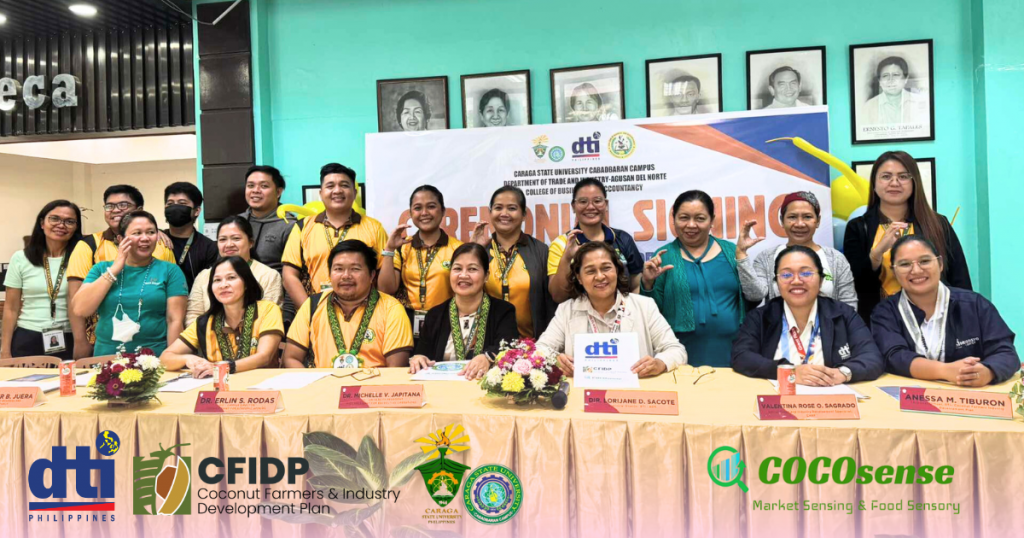
Butuan City, Philippines – The Department of Trade and Industry (DTI) Agusan del Norte and the College of Business and Accountancy of Caraga State University – Cabadbaran Campus (CSU-Cabadbaran) have released the research highlights and results from CocoSense, a collaborative project conducted in November 2024. Conducted under the “CocoSense” activity banner of DTI’s Coconut Farmers Industry Development Program (CFIDP) Agusan del Norte (ADN), this market research and sensing provides significant insights into the consumer landscape for coconut-based products, identifying substantial opportunities and outlining strategic recommendations for local businesses.
The research, undertaken by experts and researchers from Caraga State University – Cabadbaran Campus with Dr. Gladys Amparado, as the lead project leader, delves into Agusan del Norte’s consumer preferences, purchasing behaviors, and market dynamics, offering a definitive roadmap for local coconut producers to enhance their competitiveness and expand their market reach. The general market research objective was to conduct market sensing of coconut-based products and to determine the current state, trends, challenges and opportunities of the coconut products market in Buenavista, Butuan City and Cabadbaran City under CocoSense’s Phase 1 Project.
The research method of this study employed a descriptive survey quantitative research design to evaluate the demand for various coconut-based products, understand consumer preferences and buying behaviors, assess key market players, and determine market trends, challenges, and opportunities. The research was conducted in the Municipality of Buenavista, Butuan City, and Cabadbaran City, involving a sample size of the following: 535 customer respondents and 10 store outlets from the province of Agusan del Norte.
Data was collected using a two-set survey questionnaire, with the first set for customers covering demographics, product demand, preferences, and buying behavior, and the second set for store outlets focusing on business profiles, production capacity, sales volume, and market insights. The instrument was validated by three experts. Data gathering involved endorsed surveys facilitated by trained enumerators, ensuring proper documentation. Collected data was tallied and analyzed using descriptive statistics, specifically frequency and percentage distribution. Ethical considerations such as autonomy, beneficence, non-maleficence, justice, and integrity were strictly followed, ensuring respondent consent, anonymity, and protection of human rights throughout the study.
Key Coconut Market Research Findings from the DTI-ADN CFIDP CocoSense Market Research in collaboration with CSU-CC:
The conclusions from the conducted CocoSense Batch 1 Market Research in Agusan del Norte (Buenavista, Butuan City and Cabadbaran City) reveal a multi-faceted market for coconut-based products:
1. Demographic Profile and Target Market
The market is predominantly young, female, and budget-conscious, with a significant concentration in Butuan City. There’s a clear need to prioritize health, wellness, and sustainability messages, particularly for the 18-34 age group, and to tailor strategies for self-employed consumers. Insights are currently shaped largely by retail perspectives, highlighting a need for more engagement with manufacturers and producers for a holistic supply chain view.
2. Current Demand and Product Preferences
A steady consumer interest exists, with varying purchase frequencies. Coconut juice/water and coconut pretzels see moderate daily demand, while Virgin Coconut Oil (VCO) and coco vinegar are purchased more occasionally, indicating their specialized appeal. Price sensitivity is high, with consumers favoring affordable options (PHP 50-100), though niche products like coco whey and coco massage oil command higher prices for quality and health benefits. Health benefits are the primary purchase driver, with flavor also essential for snacks.
3. Consumer Preferences (Health, Taste, and Affordability)
Consumer preference is strongly influenced by health benefits, taste, and organic certification, with VCO and coco vinegar being the most popular. Organic certification is highly valued, reflecting demand for sustainable products. While most products are seen as affordable, price sensitivity remains a decisive factor, with consumers highly responsive to discounts and promotions.
4. Purchasing Behavior and Channels
Supermarkets and grocery stores are the dominant purchase channels, emphasizing convenience and immediate access. While online shopping interest is relatively low, it presents a growth opportunity with improved e-commerce strategies. Word-of-mouth and traditional marketing (TV/Radio) remain relevant, alongside the growing influence of digital marketing, particularly social media. VCO leads the market, but there’s growth potential for emerging products like coconut-based snacks and wellness items through better marketing and consumer education.
5.Operational Challenges and Market Opportunities
Many coconut-based products face limitations in sales volume and production capacity, with monthly sales often under 1,000 bottles, and small-scale warehouses limiting growth. Sourcing raw materials is challenged by limited suppliers and high prices, alongside marketing challenges from low consumer awareness. Logistical issues, particularly transportation delays and storage limitations, also hinder operations. Conversely, promising market opportunities exist in expanding product lines (health supplements, snacks, beauty products), targeting the youth and fitness markets, strengthening partnerships with grocery chains and online retail, and adopting eco-friendly packaging.
The market research provides actionable recommendations for businesses in the coconut-based product sector:
1. Targeted Marketing & Product Development
Businesses shall emphasize health, wellness, and sustainability for the young, female, and budget-conscious market, focusing on the 18-34 age group. Marketing shall highlight beauty and health benefits for women while appealing to men. Affordable, convenient options should be prioritized, especially for employed individuals and students. Strategies shall also cater to self-employed consumers.
2.Product Diversification & Pricing Strategy
Focus on offering a variety of products to meet different consumer needs. Prioritize competitive pricing (PHP 50-100 range) for everyday items and emphasize health benefits and premium quality for specialized products like VCO and coco vinegar. Niche products like coco whey and coco massage oil can target health-conscious consumers willing to pay more.
3. Enhancing Distribution & Market Reach
Retail strategies shall focus on supermarkets for broad distribution, enhancing visibility in convenience stores and specialty shops. E-commerce shall be expanded, especially for niche products. Strengthen e-commerce platforms with better user experiences and promotions. Ensure consistent product availability in supermarkets, grocery stores, and local markets.
4. Strengthening Operations & Supply Chain
Prioritize investments in infrastructure and operational efficiency, expanding storage facilities, particularly through larger, centralized warehouses. Improve product handling and storage processes by adopting modern inventory management systems. Explore partnerships or shared warehousing solutions. Diversify the supplier base and establish partnerships with local farmers for a steady and cost-effective raw material supply.
5. Boosting Sales & Addressing Challenges
Develop targeted marketing strategies for underperforming products like Coco Whey and Coco Toyo. Increase production capacity of high-performing products like Coco Cookies and Coco Massage Oil. Regularly assess market demand and align production. Introduce discounts, promotions (Buy-One-Get-One-Free), and occasional price reductions. Adopt a multi-channel marketing approach, blending traditional methods (TV/radio ads, in-store) with digital strategies (social media). Address low consumer awareness through educational campaigns and digital storytelling.
“This market research, conducted under our ‘CocoSense’ initiative, is a pivotal step forward for the coconut industry in Agusan del Norte,” said Ms. Lorijane Sacote, DTI-ADN Provincial Director. “The detailed conclusions and recommendations provide our local entrepreneurs with a clear roadmap to innovate, expand, and meet the evolving demands of the market, ultimately contributing to the economic upliftment of our coconut farmers. We are confident that by applying these insights, our local businesses can achieve sustained growth and enhance their competitiveness.”
Dr. Gladys Amparado, a market research specialist of CSU-CC and the project leader for the market research activity added, “We are proud to have collaborated on this vital research. Our findings underscore the immense potential of coconut-based products and offer practical strategies for businesses to overcome challenges and capitalize on new opportunities. We believe these insights will foster sustainable growth and strengthen the region’s position in the national coconut industry.”
DTI Agusan del Norte, in partnership with Caraga State University – Cabadbaran Campus, is committed to supporting the implementation of these recommendations to have a more vibrant and resilient coconut-based product industry in Caraga region. ♦
Date of Release: 21 July 2025





